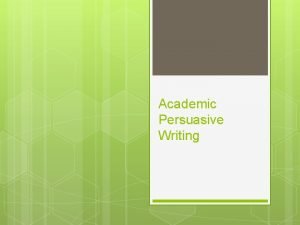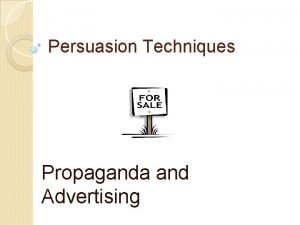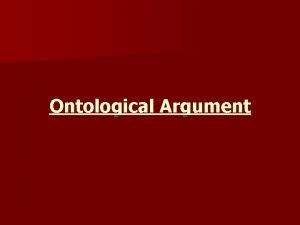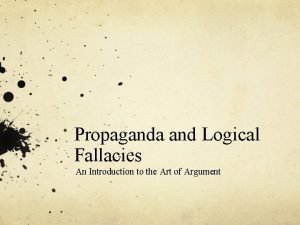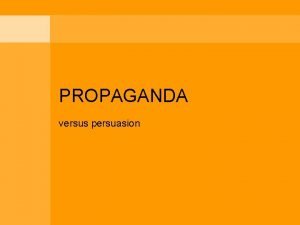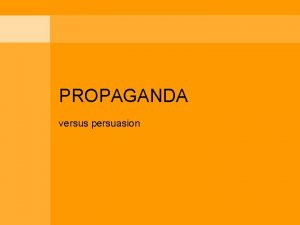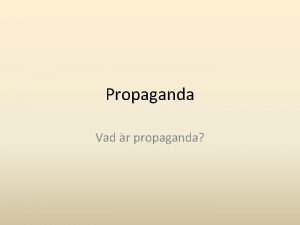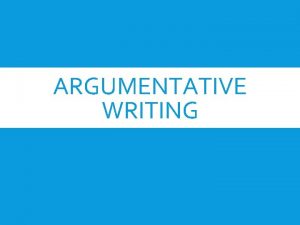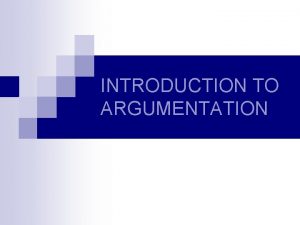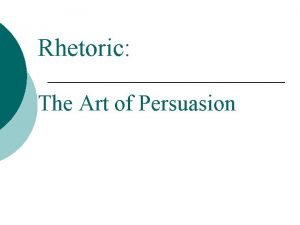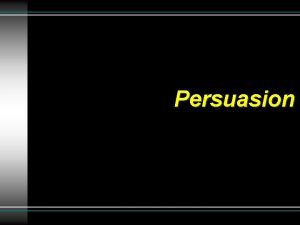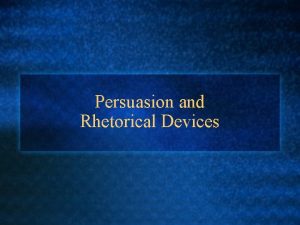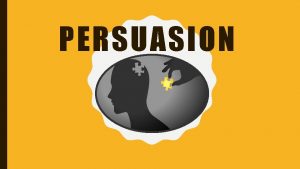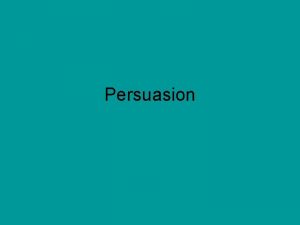Argument vs Persuasion vs Propaganda Evidence matters Learning













- Slides: 13

Argument vs Persuasion vs Propaganda Evidence matters!

Learning Targets Argumentative Reading Unit LT 1: I can analyze the impact of an author’s specific word choices on meaning and tone. LT 2: I can determine an author’s point of view or purpose in a text. LT 3: I can analyze how an author distinguishes his/her point of view from that of others. LT 4: I can identify the arguments and specific claims presented in a text. LT 5: I can evaluate the arguments and specific claims in a text. LT 6: I can assess whether the reasoning in an argument is sound. LT 7: I can assess whether the evidence is sufficient to support a claim. LT 8: I can present claims and findings in a focused, coherent manner. LT 9: I can use appropriate eye contact, adequate volume, and clear pronunciation in presentations.

+ When you think of argument, does it look something like this?

+ How would you describe the argument you just saw? ONE WORD. . .

+ Next example -Background on the situation This video was taken by a local parent when the family was in an airport on a trip. As part of routine security measure, the TSA official asks the parent if she can pat down the family’s 6 year-old daughter.

+ The family’s argument…

+ How does this argument compare the first one we viewed? THINK PAIR SHARE

+ When is arguing a good thing? n. When you’re… npresenting reasons and evidence nto reach a conclusion nwhile remaining ncalm ncomposed nunemotional

Why You Should Know the Difference • Most college writing is ARGUMENT writing--you need to support ideas LOGICALLY with EVIDENCE. • If you do not analyze the writer’s purpose, you may get suckered into believing something that isn’t logical. • If you do not recognize the manipulation of propaganda, you will fall prey to advertisements and political ads--then you will make a poor purchase OR cast a poor vote.

Essential Vocabulary Argumentative Reading Unit (copy these definitions on your paper) specific word choices--the words and phrases an author uses to express a point of view author’s point of view--the author’s opinion or viewpoint (indicated by his/her word choice and connotations) author’s purpose--the specific reason an author writes a text argument--the author’s overall position or stance on an issue claims--the reasons or main ideas used to prove the argument counterargument--the way an author addresses the opposing position; this is how an author distinguishes his/her opinion from that of others evaluate, assess--judge the effectiveness or quality of evidence (NOT textual evidence)--the specific details an author uses to support a claim (which is used to prove the writer’s argument) reasoning--support for conclusions made through logical thought sound evidence--evidence that is logical and true sufficient evidence--using ENOUGH evidence to clearly and strongly support an argument

• • • What’s the Difference? An argument • Persuasion focuses Propaganda Argument Purple = techniques used Green = counterargument focuses on proving or disproving a point for the reader Uses logical reasoning and factual evidence to prove a point; based on research; considers others’ perspectives on the issue Includes a counterargument to address the on influencing/changin g others’ beliefs and actions • • Uses a blend of facts and opinions to make others do or believe something; might consider others’ perspectives on the issue Only includes a counterargument if it helps the writer • Propaganda focuses on making others accept the writer’s beliefs without thinking • Uses assumptions and biases to manipulate your emotions; uses little or no evidence or logic; only considers its own message • Ignores all counterarguments; may even lie about them

• • • Examples Argument--“Mothers Against Drunk Driving” What is the ARGUMENT posed in this PSA? What facts are used as EVIDENCE to support this argument? Evaluate the evidence given in this PSA. Is it sound, sufficient, or both? Explain. Persuasion--2012 Romney campaign ad What is the PURPOSE of this campaign ad? What facts does Romney give? What opinions? Why does Romney talk about his opponent, Barack Obama? Is Romney’s evidence sound, sufficient, BOTH, or NEITHER? Explain. Propaganda--German Election poster from the 1932 Presidential Election Who is the targeted audience of this poster? What is the purpose of this poster? What claim does this poster use to accomplish its purpose? • • •

Click here to return to previous slide. “German Women Think of Your Children” he n t m ma o r F Ger l a i t 2 n 3 e 19 esid ns Pr ectio El “Vote Hitler”
 Argument vs persuasion
Argument vs persuasion Transfer advertising technique examples
Transfer advertising technique examples Persuasion vs propaganda
Persuasion vs propaganda Ontological argument
Ontological argument Circular argument propaganda
Circular argument propaganda Cuadro comparativo e-learning b-learning m-learning
Cuadro comparativo e-learning b-learning m-learning Secondary sources
Secondary sources Primary evidence vs secondary evidence
Primary evidence vs secondary evidence Secondary sources
Secondary sources Primary evidence vs secondary evidence
Primary evidence vs secondary evidence Jobs vancouver
Jobs vancouver Fiber evidence can have probative value as class evidence.
Fiber evidence can have probative value as class evidence. Class vs individual evidence
Class vs individual evidence Individual evidence can have probative value.
Individual evidence can have probative value.
